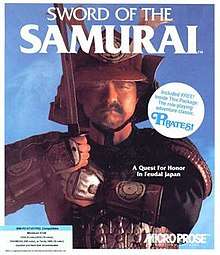Sword of the Samurai (video game)
Sword of the Samurai is an action and strategy video game developed and published by MicroProse in 1989 for the DOS platform. It features role-playing, strategy, and arcade elements set in feudal Japan. The player begins the game as a little-known vassal samurai; his ultimate goal is to replace Oda Nobunaga as the daimyō responsible for reunifying sengoku Japan.
| Sword of the Samurai | |
|---|---|
 | |
| Developer(s) | MPS Labs |
| Publisher(s) | MicroProse |
| Designer(s) | Lawrence Schick |
| Programmer(s) | Jim Synoski |
| Artist(s) | Michael Haire |
| Writer(s) | Jeff Briggs Sandy Petersen Lawrence Schick |
| Composer(s) | Jeff Briggs |
| Platform(s) | MS-DOS |
| Release | 1989 |
| Genre(s) | Action, strategy |
| Mode(s) | Single-player |
Tommo purchased the rights to this game and digitally publishes it through its Retroism brand in 2015.[1] The game was re-released in 2014 on Gog.com and Steam with support for Windows, macOS, and Linux.
Gameplay
The game begins by giving the player their choice of name, clan, and family specialty. Within the game, death is final and frequently risked; an early priority is establishing a family, which permits the player to continue as the samurai's heir in the event of death or retirement. In the first two sections of the game, the player rises from a minor retainer to a more powerful lieutenant and then to daimyō over his entire clan. At each of these levels, he competes to curry favor from his lord with three computer-controlled rivals who also seek to become first in favor and next in succession. Each samurai has several properties, including land holdings, army size, sword-fighting ability, and generalship. In keeping with the Bushidō theme of the game, army size and honor have the greatest influence over how the samurai are ranked.
A wide array of dishonorable actions are also possible. The player (and AI controlled characters) may kidnap and rescue family members, dishonor other samurai, or even assassinate their rivals or lord. Naturally, such behavior carries serious risk. The samurai performs these acts personally and risks capture or death. At minimum, exposure entails loss of honor and land and more serious offenses require ritual suicide (seppuku); a failed attempt on the life of the samurai's lord occasions the extermination of his entire family, losing the game.
After becoming a daimyō, the game shifts to a wargame format, with the goal of conquering enough provinces to claim the title of shōgun. The player no longer wanders personally through a provincial map but directs his army through the three lower Japanese islands. He is able to direct his underlings to deal with any sword fight or melee minigames without loss of honor: the focus is on the size of the player's army and mastery of the battlefield tactics.
After winning the game, the player is given a final summary of the future of his dynasty. Depending on various factors such as the victor's honor and the presence of an adult heir, the length of the dynasty could range from hundreds of years (like the Tokugawa shogunate) to a quick dissolution after the shōgun's death (as occurred with Oda Nobunaga and Toyotomi Hideyoshi).
Development
MicroProse designers Sid Arnold and Lawrence Schick began development of Sword of the Samurai in late 1987, after the success of the company's first role-playing adventure game Sid Meier's Pirates!. They chose to set it during the Sengoku period because the era's chaos made it possible for samurai to gain great power regardless of background, and gave players the goal of uniting the country and becoming shōgun. MicroProse co-owner Sid Meier helped develop the NPCs' artificial intelligence and the dueling.[2]
Reception
Computer Gaming World stated in 1990 that Sword of the Samurai "offers even more than its spiritual ancestor, Pirates!". It praised the game's graphics, soundtrack, and many choices during gameplay.[3] Later that year and in 1993 the magazine gave it four stars out of five, stating that the game did not sell as well as Pirates! despite "near perfect" game play and historical accuracy.[4][5]
References
- "Purchase Agreement between Atari, Inc. and Rebellion Developments, Stardock & Tommo" (PDF). BMC Group. 2013-07-22.
- Schick, Lawrence (January 1990). "Designer's Notes / The Secret History of Sword of the Samurai". Computer Gaming World. p. 84. Retrieved 15 November 2013.
- Wilson, Johnny L. (January 1990). "Unsurpassable Honor / "Sword of the Samurai" from MicroProse". Computer Gaming World. p. 18. Retrieved 15 November 2013.
- Brooks, M. Evan (October 1990). "Computer Strategy and Wargames: Pre-20th Century". Computer Gaming World. p. 11. Retrieved 16 November 2013.
- Brooks, M. Evan (June 1993). "An Annotated Listing of Pre-20th Century Wargames". Computer Gaming World. p. 136. Retrieved 7 July 2014.